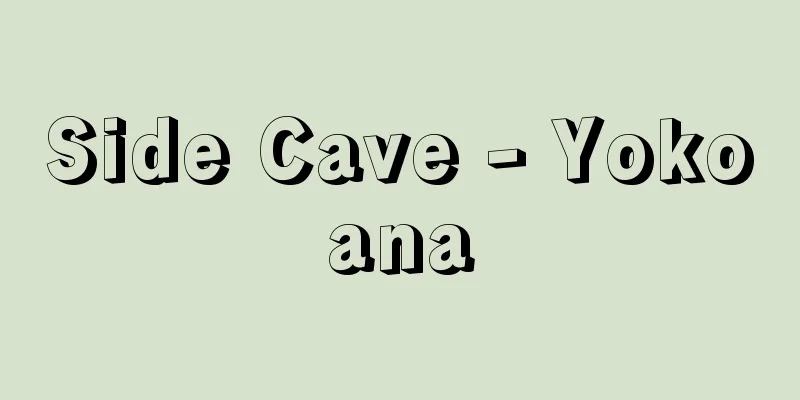Side Cave - Yokoana

|
A burial facility from the late Kofun period to the Nara period, it is a burial hole dug into the slope of a hill or plateau. It is a type of kofun, also called a "horizontal hole kofun" or "horizontal hole tomb," but it is different from a high mound kofun, which has a stone chamber and earthwork. The hole dug into the slope is shaped like a horizontal stone chamber, so it is found in areas with relatively soft rocks such as tuff, loam, and sandstone, which are structurally easy to dig, but have stable foundations. They are distributed nationwide, and are particularly dense in Kumamoto, Miyazaki, Shimane, Kanagawa, Chiba, Tokyo, Saitama, Ibaraki, Fukushima, and Miyagi. They usually exist in clusters, with a few or several dozen in number, and some, such as the Yoshimi Hyakuana in Saitama Prefecture, have hundreds of holes. The shape of the caves varies depending on the region and time period, but generally consists of a wide and high burial chamber and a narrow and low passage. It is thought that it developed in close relation to the cave-type stone chambers because of its structure, and the caves in northern Kyushu, which adopted the cave-type stone chambers as burial facilities for kofun tombs early on, are often dated to the 6th century, whereas those in eastern Japan date back to the 7th or 8th century, but their origins tend to date back to the 5th century. The passage of the cave-type stone chambers is shorter than that of the cave-type stone chambers, and in some of the more recent ones, it is difficult to distinguish the boundary between the burial chamber and the passage. In addition, a vestibule or a burial passage that is thought to be a place of rituals may be attached in front of the passage. A coffin seat, a corpse bed, and a drainage ditch are made on the floor of the burial chamber, but it is common for people to be buried together with others in a post-burial burial, and multiple human bones are often found. The plan of the burial chambers includes square, triangular, square with rounded corners, and bottle-shaped, while the cross-sections are pentagonal, triangular, and semicircular. Generally, older ones have a square plan and a pentagonal cross-section, while newer ones have a bottle-shaped plan and a semicircular cross-section. Some have ceilings carved into the shape of a house roof, and the walls have carved and painted murals using line drawings, colored paintings, or both techniques. The entrance gates are closed off by placing wood or stone in a door-like shape, or by piling up pebbles. Early caves that are clustered together tend to be carved horizontally in a line on the same slope, but as time goes on, they become more densely packed together in a beehive-like shape. The grave goods are the same as those excavated from the cave-type stone chambers that were built at the same time, but the amount is generally poor. However, among the clustered cave tombs, only one or two have abundant grave goods, so they cannot be simply compared with the layer of the buried in the cluster tombs with cave-type stone chambers. There are also cases where a clustered mound tomb on a high mound was built on the plateau and a cluster of cave tombs built at the same time on a nearby slope, and it is not clear whether the difference between the two indicates a class difference or something like a tribal difference. [Kihachiro Goto] "Sakuzume Shuichi et al., "Current Status of Research on Cave Tombs" (Archaeological Journal 110, 1975, New Science Press)" ▽ "Ikegami Satoru, "Archaeological Library 6: Cave Tombs" (1979, New Science Press)" [Reference] |A group of cave tombs from the late Kofun period, with 237 caves opening into the slopes of a tuff-like hill. They were once touted as the remains of cave dwellings of ancient people, and became famous. The luminous moss that grows naturally in the caves is a nationally designated natural monument. Nationally designated historic site Yoshimi Town, Hiki District, Saitama Prefecture ©Shogakukan "> Yoshimi 100 Caves Source: Shogakukan Encyclopedia Nipponica About Encyclopedia Nipponica Information | Legend |
|
古墳時代後期から奈良時代の埋葬施設の一つで、丘陵や台地の斜面にうがたれた埋葬用の穴をいう。古墳の一種であり、「横穴古墳」「横穴墓」ともよばれるが、石室や盛り土をもつ高塚古墳とは異なる。斜面にうがたれる穴は、横穴式石室状の形状を呈するため、構造上掘りやすい凝灰岩質、ローム質、砂岩質など比較的軟質ではあるが、基盤の安定した地質の地方にみられる。分布は全国的な広がりをもち、とくに熊本、宮崎、島根、神奈川、千葉、東京、埼玉、茨城、福島、宮城などで濃密である。普通、群集して存在しており、その数は数基、数十基のものや、埼玉県の吉見(よしみ)百穴のように数百基を数えるものもある。 横穴の形態には地域や時期差による多様性がみられるが、一般的には広くて高い玄室と、狭くて低い羨道(せんどう)からなる。その構造から横穴式石室との密接な関係をもって発展したものと考えられ、古墳の埋葬施設として早く横穴式石室を採用した北部九州の横穴は、東日本のものが7、8世紀に下るのに対して、6世紀に比定されるものが多いが、発生時期については5世紀にさかのぼる傾向にある。横穴の羨道部は、横穴式石室に比べて短く、時期の下るものには玄室と羨道の境の区別のできないものがある。ほかに羨道部の前方には祭祀(さいし)の場所と考えられる前庭部や墓道が付設される場合がある。玄室の床面には、遺骸(いがい)を安置する棺座・屍床(ししょう)や排水溝がつくられるが、追葬による合葬が一般的であり、複数の人骨が検出されることが多い。玄室の平面形には方形、三角形、隅丸(すみまる)方形、とっくり形などがあり、断面形では五角形、三角形、半円形に近い形状を示す。一般的に平面形が方形で断面形が五角形に近いものが古く、平面形がとっくり形で断面形が半円形のものが新しい。なかには天井部を家屋の屋根状に掘り込んだり、壁面に線刻画、彩色画や両方の技法を用いた刻彩色の壁画をもつものがある。羨門は木や石を扉状に立てたり、礫(れき)を積み上げて閉塞(へいそく)している。群集する初期の横穴は、同一斜面に一列に横にうがたれる傾向をもつが、時期が下るにつれ蜂(はち)の巣(す)状に密集する。 副葬品は、併行して築造される横穴式石室から出土するものと共通するが、その量は全体的に貧弱である。しかし、群集する横穴のなかには一ないし二基だけに豊富な副葬品をもつものがあり、横穴式石室をもつ群集墳の被葬者層と単純には対比できない。また台地上には高塚の群集墳が、すぐ近くの斜面には同一時期の横穴群が築成されている例もあり、両者の違いが階層差を示すものか、部族の違いのようなものか明らかでない。 [後藤喜八郎] 『酒詰秀一他「横穴墓研究の現状」(『考古学ジャーナル110』所収・1975・ニューサイエンス社)』▽『池上悟著『考古学ライブラリー6 横穴墓』(1979・ニューサイエンス社)』 [参照項目] |凝灰岩質の丘陵斜面に237基もの横穴が開口する古墳時代後期の横穴墓群。かつて古代人の穴居住居跡として喧伝され、有名になった。横穴内に自生するヒカリゴケは国指定天然記念物。国指定史跡 埼玉県比企郡吉見町©Shogakukan"> 吉見百穴 出典 小学館 日本大百科全書(ニッポニカ)日本大百科全書(ニッポニカ)について 情報 | 凡例 |
<<: Yokoi Kanaya - Yokoi Kinkoku
Recommend
Ishigure Pass
...There are many mountain passes across the area...
Kitano Shrine
This shrine is located in Bakuro-cho, Kamigyo-ku, ...
Pasig River (English spelling)
A river that crosses Manila from east to west in s...
Beidaihe
A resort located on the coast of Qinhuangdao City...
"Okuni Kabuki Zoushi"
...In other words, in hand-painted genre painting...
Skim milk
…the fat-rich part of milk, i.e. the part remaini...
Haikou Port
…Population: 390,000 (1994). During the Song Dyna...
Spiritualism - Yuishinron (English spelling) spiritualism
A theory that preaches the independent existence a...
Fables
...Because of the fame of his allegorical poems, ...
New Year's sake - Toso
A medicinal liquor drunk as a celebration at the ...
oleoresin
…Extracts contain coloring matter, oils, resins, ...
Nosed dragonfly - Nosed dragonfly
An insect of the family Anthocephalidae in the or...
Iconium
…Located at an altitude of 1,025m on a key transp...
Maianthemum bifolium (English spelling)
…[Tetsuichi Yahara]. … *Some of the terminology t...
Tetrapturus belone (English spelling) Tetrapturusbelone
…[Toru Taniuchi]. … *Some of the terminology that...









